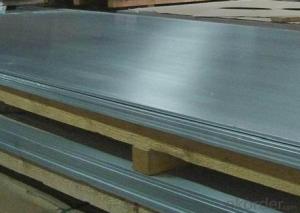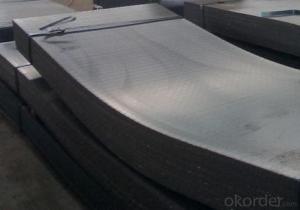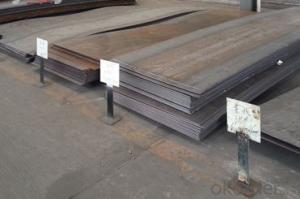Hot Rolled Carbon Steel Plate,Carbon Steel Sheet Q345A, CNBM
- Loading Port:
- Qingdao
- Payment Terms:
- TT OR LC
- Min Order Qty:
- 10 pc
- Supply Capability:
- 30 pc/month
OKorder Service Pledge
OKorder Financial Service
You Might Also Like
Quick Details
| Standard: | AISI, ASTM, GB, JIS | Grade: | Q195,Q235,Q345,A36,C45 | Thickness: | 1.0-30MM |
| Model Number: | Q235,Q195,Q345 | ||||
| Type: | Steel Plate | Technique: | Hot Rolled | Surface Treatment: | Coated |
| Application: | Ship Plate | Special Use: | Silicon Steel | Width: | 30-2000mm |
| Length: | as your requirement | standard: | hot rolled | Surface: | Anti-rust oil |
Packaging & Delivery
| Packaging Details: | seaworthy packages or as customers' require |
| Delivery Detail: | within 15 days after the advance payment |
Hot rolled steel plate
1 carbon steel plate 3mm thick General information
| Product name | Type | Specification | Implementation of GB | ||
| thick | wide | long | |||
| Carbon structural steel | Q195,Q215, Q235A,Q235B, Q235C,Q255, Q275 | 4-120 | 1500-4500 | 6000-12000 | GB/T700-2006 |
| Low-alloy structural steel | Q295,Q345A, Q345B,Q2345C | 4-120 | 1500-4500 | 6000-12000 | BG/T1591-1994 |
| Quality carbon structural stee | 30-50 | 4-120 | 1500-4500 | 6000-12000 | BG/T699-1999 |
| Ship steel | CCSA,CCSB | 4-120 | 1500-4500 | 6000-12000 | materials and welding condition |
| CCSAH32,CCSAH36 CCSDH32,CCSDH36 | 4-120 | 1500-4500 | 6000-12000 | materials and welding condition or GB 712-2000 | |
| Boiler steel | 20g,22Mng, 16Mng,19Mng | 4-120 | 1500-4500 | 6000-12000 | GB 713-1997 |
| Pressure vessel steel | 1622Mng,20R, 15MnVR,15MnVNR | 4-120 | 1500-2700 | 6000-12000 | GB 6654-1996 |
| European standard plate
| S235JR,S235J0, S275JR,S275J0, S275JR2,S355JR, S355J0,S355J2 | 4-120 | 1500-4500 | 6000-12000 | EN 10025 |
| Japanese standard plate | SS400,SS400-B | 4-120 | 1500-4500 | 6000-12000 | JIS G3101-2004 |
2 carbon steel plate 3mm thick detail specification
Material:
A283Gr.D/A573Gr.65,A516Gr65,A516Gr70,A284Gr.D
SS400,SS300,CCSB A36,A32,LRA32,LRB,Q235
Q195,Q235,Q345,SS400,ASTM A36,E235B
Thickness: 4mm-120mm
width: 1500mm-4500mm
Length:2-10m ,accordingly
Thickness | 4-120mm |
Width | 1500-4500mm or as custom's request |
Length | 2-12m,as your requirment |
Technique | Cold rolled or hot rolled |
Surface treatment | Bare, galvanized coated or as customer's requirements. |
Standard | ASTM,EN,GB,JIS,GB |
Material | A283Gr.D/A573Gr.65,A516Gr65,A516Gr70,A284Gr.D SS400,SS300,CCSB A36,A32,LRA32,LRB,Q235 Q195,Q235,Q345,SS400,ASTM A36,E235B |
Terms of Payment | L/C or T/T |
Chemical composition | C≤0.004%;Si≤0.030%; Mn ≤0.17%;P≤0.012%; S≤0.010%; Fe balance |
Delivery Detail | within 30days once receive deposite or confirm L/C |
Packing | Standard export packing,or as requirement |
3 carbon steel plate 3mm thick application:
construction,machinery manufacturing, container manufacturing, shipbuilding, bridge construction. Can also be used to manufacture a variety of containers, the furnace shell, furnace plate, bridge and vehicle static steel plate, low alloy steel plate,shipbuilding plate, boiler plate, pressure vessel plate, pattern plate, tractor parts, automobile frame steel plate and welding components
- Q:What are the functions and classifications of galvanized sheet?
- Galvanized sheet mainly used in industry: a large number of galvanized sheet, used in automobile manufacturing, refrigeration, construction, ventilation and heating facilities and furniture manufacturing and other fields. Galvanized steel anticorrosion method becomes important, not only because the zinc can form a protective layer on the surface of iron and steel, but also because zinc has the effect of cathodic protection, when the breakage of zinc coating, it can still prevent iron base metal corrosion by cathodic protection.
- Q:What are the different coating options for steel sheets (powder coating, paint, etc.)?
- Steel sheets have a variety of coating options that each have their own unique benefits and characteristics. Some commonly used coating options include: 1. Powder coating: Dry powder coating material is applied to the steel sheet and then cured under heat to create a protective layer. This coating offers excellent durability, corrosion resistance, and aesthetic appeal. It is also environmentally friendly as it does not contain solvents or VOCs. 2. Paint: Liquid paint is applied to the surface of the steel sheet and dries to form a protective layer. Paint coatings come in a wide range of colors and finishes, making them suitable for different applications. However, they may require regular maintenance and can chip or peel. 3. Galvanizing: Galvanizing is a popular method for coating steel sheets, particularly when corrosion resistance is important. A layer of zinc is applied to the steel surface through a hot-dip process, creating a protective barrier against corrosion and rust. Galvanized coatings are highly durable and long-lasting. 4. Epoxy coatings: Epoxy coatings are known for their excellent chemical resistance and adhesion properties. They provide a tough and durable finish that protects steel sheets from corrosion, chemicals, and abrasion. Epoxy coatings are commonly used in industrial settings with harsh conditions. 5. Chromate conversion coatings: Chromate conversion coatings are applied to steel sheets to enhance their corrosion resistance and improve paint adhesion. These coatings are usually thin and translucent, giving a clear or slightly yellowish appearance. They are often used as a pre-treatment before painting or powder coating. 6. Ceramic coatings: Ceramic coatings offer exceptional heat resistance and durability. They are commonly used in high-temperature applications such as exhaust systems or industrial ovens. Ceramic coatings can withstand extreme temperatures, corrosion, and abrasion, making them ideal for demanding environments. There are many other coating options available for steel sheets. The choice of coating will depend on factors such as the intended application, desired appearance, environmental conditions, and budget. Seeking advice from a coating specialist or manufacturer can help determine the most suitable option for specific requirements.
- Q:What is the maximum load-bearing capacity of steel sheets?
- The specific type and thickness of steel sheets can cause the maximum load-bearing capacity to vary. Steel sheets are generally known for their strength and durability, which allows them to handle heavy loads. The load-bearing capacity of steel sheets is typically measured by its yield strength or ultimate tensile strength. Yield strength refers to the maximum stress a steel sheet can handle before permanently deforming, while ultimate tensile strength refers to the maximum stress it can handle before fracturing. The load-bearing capacity of steel sheets can range from a few hundred pounds to several thousand pounds per square inch (psi). For instance, mild steel sheets usually have a yield strength of approximately 50,000 psi, enabling them to support moderate loads. Conversely, high-strength steel sheets can have a yield strength of over 100,000 psi, allowing them to withstand heavy loads. It's important to consider that the load-bearing capacity of steel sheets can also be affected by factors such as dimensions, surface condition, and support method. Moreover, engineers and structural designers often take safety margins and the factor of safety into account when determining the maximum load-bearing capacity of steel sheets for specific applications. Therefore, it is advisable to consult relevant engineering standards, specifications, or professionals for accurate load-bearing capacity information in a particular context.
- Q:What is the typical thermal conductivity of a steel sheet?
- The typical thermal conductivity of a steel sheet is around 50-60 W/mK.
- Q:What is the difference between a pre-annealed and full hard steel sheet?
- A pre-annealed steel sheet is a steel sheet that has undergone the annealing process. This process includes heating the steel to a specific temperature and then cooling it slowly. By doing so, internal stresses in the steel are relieved and its ductility and workability are improved. Consequently, pre-annealed steel sheets possess greater formability and are more easily shaped and manipulated compared to their non-annealed counterparts. On the flip side, a full hard steel sheet has not been subjected to the annealing process and maintains its original hardness and strength. These sheets are commonly used in applications that necessitate high strength, durability, and resistance to deformation. They are less ductile and more rigid, which makes them suitable for situations where shape retention and stiffness are crucial, such as in automotive components or structural supports. In conclusion, the primary distinction between pre-annealed and full hard steel sheets lies in their formability and strength characteristics. Pre-annealed steel sheets are more malleable and easier to shape, while full hard steel sheets offer greater strength and rigidity. The choice between the two depends on the specific requirements of the application and the desired balance between formability and strength.
- Q:What is the average cost of stainless steel sheets?
- Various factors, such as the grade, thickness, size, and supplier, contribute to the fluctuating average cost of stainless steel sheets. Prices for these sheets typically span from $30 to $300 per sheet. Lower-grade options tend to be budget-friendly, whereas higher-grade varieties can be pricier. Moreover, thicker sheets command a higher price due to the increased material used. Considering these elements and exploring multiple options is crucial to finding the most suitable price and quality for your individual requirements.
- Q:Are steel sheets suitable for railway carriages?
- Yes, steel sheets are suitable for railway carriages. They provide strength, durability, and resistance to wear and tear, making them an ideal choice for the construction of railway carriages.
- Q:What is the average lead time for manufacturing steel sheets?
- The average lead time for manufacturing steel sheets can vary depending on various factors such as the size and complexity of the order, the current production capacity, and any specific requirements. However, on average, it typically ranges from a few weeks to a couple of months.
- Q:Are steel sheets available in different hardness levels?
- Yes, steel sheets are available in different hardness levels.
- Q:Are steel sheets resistant to impact or damage?
- Steel sheets possess remarkable strength and durability, attributes that render them exceptionally resistant to impact and damage. Their robust tensile strength enables them to endure substantial loads and withstand external forces without deformation or breakage. Thus, they find extensive use in critical applications that demand impact resistance, such as construction, automotive manufacturing, and industrial settings. Furthermore, steel sheets exhibit exceptional resilience against extreme temperatures, corrosion, and environmental factors, further enhancing their overall resistance to damage. However, it is worth noting that the degree of impact or damage resistance may vary depending on the thickness, quality, and composition of the steel sheet.
1. Manufacturer Overview |
|
|---|---|
| Location | |
| Year Established | |
| Annual Output Value | |
| Main Markets | |
| Company Certifications | |
2. Manufacturer Certificates |
|
|---|---|
| a) Certification Name | |
| Range | |
| Reference | |
| Validity Period | |
3. Manufacturer Capability |
|
|---|---|
| a)Trade Capacity | |
| Nearest Port | |
| Export Percentage | |
| No.of Employees in Trade Department | |
| Language Spoken: | |
| b)Factory Information | |
| Factory Size: | |
| No. of Production Lines | |
| Contract Manufacturing | |
| Product Price Range | |
Send your message to us
Hot Rolled Carbon Steel Plate,Carbon Steel Sheet Q345A, CNBM
- Loading Port:
- Qingdao
- Payment Terms:
- TT OR LC
- Min Order Qty:
- 10 pc
- Supply Capability:
- 30 pc/month
OKorder Service Pledge
OKorder Financial Service
Similar products
New products
Hot products
Related keywords






























